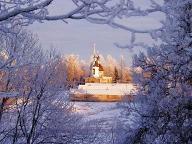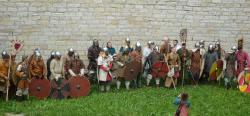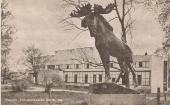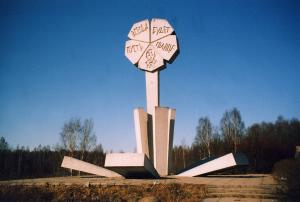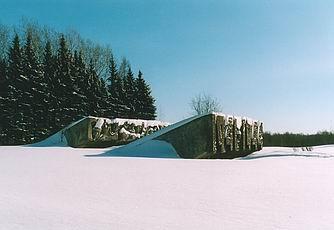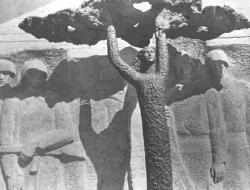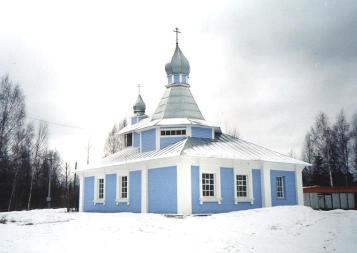Articles
/
"Green Belt of Glory", memorial constructions complex
"Green Belt of Glory", memorial constructions complex
Subject /
Architecture/Sculpture, monuments, memorials
"The Green Belt of Glory" is a memorial construction complex at the line of the battle of Leningrad in 1941-1944. The complex was created to immortalize the memory about its heroic defenders. The first construction of the future complex had been appeared at the period of the World War II, it was a stele between Ligovo and Sosnovaya Polyana (1944; architects K.L. Iogansen, V.A. Petrov); then an obelisc in Peterhof Road was constructed at the fork of roads to Krasnoye Selo and Petrodvorets (1946; the same architects). Now these monuments are included into the memorial "Kirovsky Val" ("Kirovsk Bank") in the territoty of St Petersburg. On 23 June 1956 the first decision of the city government about building monuments to heroes of the defence of Leningrad was published. According to this decision were constructed: the obelisk at Moscow Road (1957), now it was included into the memorial "Shturm" ("The Storm") (the architect M.K. Melikhova), the granite stele at the 32th km of Peterhof Road (1961; the architect O.I. Sokolova), later it was a part of the memorial "Primorsky" ("The Seaside"). An idea about the necessity of creating the united complex of military memorials around Leningrad was expressed in 1965 and had met with approval of the city government. A project of the memorial general layout was developed from 1958 to 1964 by employees of the architectural design department of Lengorispolkom (the Leningrad City Executive Committee) and the First workshop of the institute Lenproekt (G.N. Buldakov, V.L. Gaykovich, M.A. Sementovskaya formed the part of the work group). "The Green Belt of Glory" plan was based the defences where enemy troops were stopped in September of 1941. The work on the elaboration of the front line and forces deployment places was done by the Headquarters of the Leningrad Command. The memorial was been erecting with "the method of people building", residents and biggest enterprises of St Petesburg took place in its construction. "The Green Belt of Glory" general length is 200 km. It is divided in several stretches: 1) "The Big Blockade Ring" (the southern coast of the Gulf of Finland - near Ligovo - the Pulkovo Heights – to the north of the town of Pushkin – to the south of the town of Kolpino – the town of Kirovsk – the right bank of the Neva River – the west shore of Ladoga Lake – the villages of Verkhniye Nikulyasi and Nizhniye Nikulyasi – the settlement of Vaskelovo – the Sestra River – the northen coast of the Gulf of Finland). Memorials "The Kirovsk Bank", "The Pulkovo Line", "Members of the Home Guard", "The Unconquered", "The Storm", "The Izhora Ramming", "The Neva Barrier", "The Neva Spot", "The Break-through", "Unnamed Height", "Lembolovo stronghold", "The Garden of Peace", "The Sister" are located on that trritory. 2) "The Small Blockade Ring" (the town of Petrodvorets – Gostilitskoye Road – the village of Porozhki – the Voronka River – the village of Kernovo). Memorials "The Seaside", "The Attack", "The Anchor", "January Thunder", "Gostilitsky", "The Distant Line", "The Bank of the Strongs" are located on this area. 3) The western and eastern areas of "The Road of Life" (villages of Lednevo - Kobona - Lavrovo – Voykobalo) with monuments "The Flower of Life", "Rumbolovo Mountain", "Katyusha", "The Broken Circle", "The Crossing", "The Steel Way" and the memorial "Kronshtadsky" on the Island of Kotlin. Different architectural works that unite sculpture, memorable signs and preserved or restored defensive installation into a single composition were included into the complex of war memorials. Parks, public gardens and memorial alleys are connecting-links between monuments which are located a long way apart. The "Green Belt of Glory" first monuments building was completed in 1965, in the 20th anniversary of the Victory. Foundation stones were laying and the first trees were planted at the places of future memorials. In 1965 projects, which were developed by Leningrad architects and sculptors, were presented in the Executive Committee of the Leningrad City Soviet and at the beginning of 1966 they were presented at the House of Architects. The Construction of memorials was done in some stages. The first monuments were built by 9 May 1967. From the end of the 1960s to the beginning of the 1970s works were continued, the most of objects were completed by May of 1975 (the 30th anniversary of the Victory). By that time more than 80 monuments, obelisks and other constructions had been on the former front line. Common military cemetery and burial places, example of defense technology, buildings and constructions marked with commemorative plaques (for example, the building in the settlement of Borisova Griva where an evacuation centre was placed from 1941 to 1942) as independent objects are included into "The Green Belt of Glory". In 1974 "The Green Belt of Glory" had got the status of the history monument of the republic significance and was taken under the state defence. Its symbolic centre is the Monument to Heroic Defenders of Leningrad that was opened on 9 May 1975 in Victory Square (ploshchad Pobedi) in St Petersburg. Building was continueing from the second half of the 1970s to the first half of the 1980s. During that period new memorials were created, built memorials were perfected, adjacent territories were equiped and trees were planted.
Authors
Karpenko, Irina Aleksandrovna
Persons
Belyayeva, G.V.
Buldakov, Gennady Nikanorovich
Gaikovich, Vladislav L.
Iogansen, Kirill Leonardovich
Melikova, Maria Konstantinovna
Petrov, Vasily Aleksandrovich
Sementovskaya, Maryana Avenirovna
Sokolova, Olga Ivanovna
Geography
Leningrad Oblast, the/Vsevolozhsk District/Borisova Griva Village
Topographical landmarks/Gulf of Finland, the
Leningrad Oblast, the/Kirovsk District/Kirovsk Town
Leningrad Oblast, the/Kirovsk District/Kobona Village
Topographical landmarks/Ladoga Lake
Leningrad Oblast, the/Kirovsk District/Lavrovo Village
Leningrad Oblast, the/Kirovsk District/Lednevo Village
Topographical landmarks/Priozerskoye Shosse (Priozersk Highway)
Topographical landmarks/Sestra River, the
Leningrad Oblast, the/Kingisepp District/Ust-Luga Settlement
Leningrad Oblast, the/Vsevolozhsk District/Vaskelovo Village
Topographical landmarks/Voronka River, the
Bibliography
Ганшин В. И., Сердобольский О. М. Кольцо памяти, кольцо славы. Л., 1988., 60-118
Лукьянов Ю.А. Рубежи стойкости и мужества. Л., 1985., 65-171
Семенова Т.М. «Каменная летопись» Великой Отечественной войны // Труды ГМИ СПб. Вып. 5. СПб., 2000, 324-343
Subject Index
"Anchor", a memorial
"Bank of Strong Man", a memorial
"Break-through", memorial
"Crossing", memorial
"Far Line", a memorial
"Gostilitsky", a memorial
"Izhora Ram", a memorial
"January Thunder", a memorial
"Katyusha" , a monument
"Kirovsky Fortification", a memorial
"Kronstadt", a memorial
"Members of the Home Guard", a memorial
"Nevsky Rapids", monument
"Nurse", a memorial
"Primorsky", memorial, the
"Primorsky", memorial, the
"Pulkovo Line", a memorial
"Rumbolovo Hill", a memorial
"Steel Way", monument
"Storm", a memorial
"Storm", a memorial
"The Broken Ring", memorial
"The Flower of Life", a memorial
"The Garden of Peace", monument, the
"The Lembolovo Fortification", memorial, the
"The Nevsky Patch", a museum
"The Unconquered", a memorial
"Unnamed Height", monument, the
Mentioned in articles:
|
hidden
|
Buldakov, Gennady Nikanorovich (1924-1990), an architect
Gennady Nikanorovich Buldakov (1924-1990), an architect. G.N. Buldakov was a veteran of World War II. After the war finishing he learned at the Leningrad Engineering-Building Institute where he taught then during 1968-1979. From 1963 Buldakov... more
|
|
|
hidden
|
Gostilitsi, village
GOSTILITSI, a village in Lomonosov District. Population: 3600. It is located at the northern edge of the Izhora Hills, on the Gostilka River. The name originates from the Novgorod name Gostilo. First mention was in Novgorod’s scribe roll of... more
|
|
|
|
hidden
|
Lomonosov District
LOMONOSOV DISTRICT. Area: 1990.8 sq. km. Population: 65,300. Established in 1927. L. D. comprises Bolshaya Izhora and Lebyazhye urban settlements and 140 rural localities. It borders St. Petersburg and Kingisepp, Volosovo, and Gatchina Districts of... more
|
|
|
|
hidden
|
Memorials to the Great Patriotic War
Memorials to the Great Patriotic War. The idea of creating memorials on the firing lines of the Leningrad defence appeared in the years of World War II. The first temporary monuments on the line of the Leningrad front were builtin 1944-45 after the... more
|
|
|
|
hidden
|
Military-historical celebrations and events
MILITARY AND HISTORICAL FESTIVITIES AND ACTIVITIES. The Russian Federation federal law “O Dnyakh Voinskoy Slavy (Pobednykh Dnyakh ) Rossiy” (“About Days of Military Glory (Victory Days ) of Russia”) was issued in 1995. The oblast programme,... more
|
|
|
|
hidden
|
Sculptures and monuments
Sculptures and monuments. The first sculpture samples appeared in St. Petersburg outskirts at the time of peter I ruling. During the 18th century decorative sculpture was the inherent part of park ensembles of Peterhof, Oraniyenbaum, Tsarskoye... more
|
|
|
|
hidden
|
"The Flower of Life", a memorial
"The Flower of Life" is a memorial consisting of "The Great Belt of Glory" at the 3d km of "The Road of Life" in the valley of the Luppa River at the village of Kovalyevo of the Vsevolozhsk District. The Memorial includes the monument "The Flower of... more
|
|
|
|
hidden
|
"The Garden of Peace", monument, the
"The Garden of Peace" is the memorial included into "The Green Belt of Glory". It is located at the 35th km of Vyborg Road. The memorial was opened on May 5, 1967. It was devoted to Leningrad defence and the feat of the 21st and 23d Army of the... more
|
|
|
|
hidden
|
"The Lembolovo Fortification", memorial, the
The memorial "The Lembolovo Fortification" is a part of the memorial "The Green Belt of Glory". It is located at the 39th km of the road to the town of Priozersk on the River Muratovka northern bank close to the settlement of Lembolovo. The... more
|
|
|
|
hidden
|
"The Road of Life", monuments
The monuments "The Road of Life". "The Road of Life" was only military-strategic transport arterial road passed through Ladoga Lake and connected blockade Leningrad with the country (the official name is the military transport road) from September... more
|
|
|
|
hidden
|
"Unnamed Height", monument, the
The monument "Unnamed Height" ("The Hill of Glory"), a monument in the complex "The Green Belt of Glory" on the right bank of the River Neva at the Ivanovsky Rapids (the Vsevolozhsk district). It was constructed by workers of the Vyborg district of... more
|
|
|
|
hidden
|
Urban settlement named after Morozov
NAMED AFTER MOROZOV, an urban settlement in Vsevolozhsk District. Population: 10,700. Located on the right bank of the Neva near its source, opposite to the Oreshek Fortress. The St. Petersburg-Nevskaya Dubrovka railway branch extends near this... more
|
|
|
|













